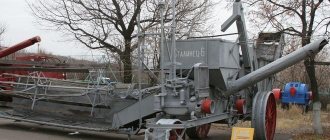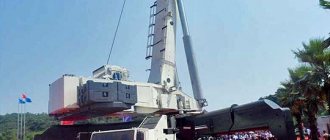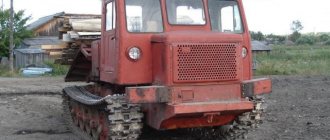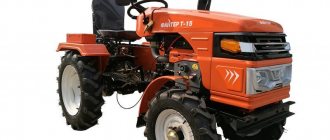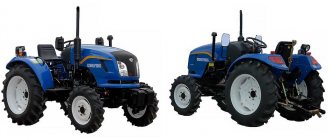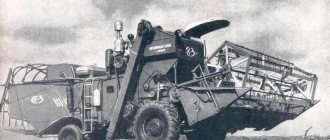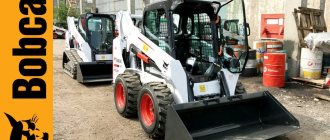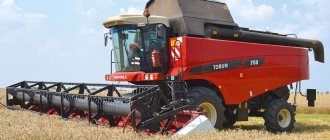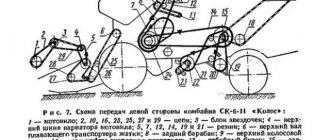Combine harvester
- a complex grain harvesting machine (reaping-thresher), which performs sequentially in a continuous flow and simultaneously: cutting bread (that is, plants), feeding it to the threshing apparatus, threshing grain from the ears, separating it from the heap and other impurities, transporting clean grain to the bunker and mechanical unloading from it.
One of the most important agricultural machines, capable of performing several different operations at once. For example, a grain harvester cuts the ears, knocks the grains out of the ears, and cleans the grains with a stream of air. A complex machine performs the functions of three simple ones - a reaper, a thresher and a winnower.
Additional accessories are available for grain harvesters that allow them to harvest different crops.
History of the combine and combine construction
The birthplace of the modern combine harvester is the USA. In 1828, S. Lane filed the first patent for a complex combined harvesting machine that simultaneously cut bread, threshed it, and husked the grain. However, this machine was not built.
The first combine harvester was invented by E. Briggs and EG Carpenter in 1836. This combine was mounted like a 4-wheeled cart; The rotation of the threshing drum and the drive of the cutting apparatus were carried out by transmission from 2 rear wheels.
In the same 1836, somewhat later, two inventors N. Moore and J. Hascall received a patent for a machine that, according to the basic principles of work processes, was close to the design of a modern type combine. In 1854, this combine was operating in California and harvested 600 acres (approx. 240 hectares). Until 1867, work on the design and creation of combines was carried out mainly in the eastern states of the United States.
In 1868, A. R. Vlasenko[1] built a combine harvester in the Russian Empire.
Built in 1875 in California, a combine designed by D. C. Peterson found much greater use than the combines of other inventors.
In 1890, the factory production of combines was already carried out by 6 companies (including Holt (English) Russian), which produced combines for sale. Combines of this type, although they were very close in their basic design to modern machines, were sharply different from the latter in their design. All Californian combines were made mainly of wood and had a large cutting apparatus grip. The movement of the combine across the field was carried out mainly by horses and mules, of which up to 40 heads were required, the working parts were driven by gears, from running wheels, and from 1889 - from a special steam engine. All this led to excessive bulkiness of the combines and their weight sometimes reached 15 tons.
In the late 1880s, about 600 California-type combines were operating on the Pacific Coast of the United States. In the early 1890s, in order to replace living traction with mechanical ones, steam self-propelled vehicles began to be used as a motive force, from which they later moved on to tractor-trailers with an internal combustion engine.
The first Holt combine, with a 36-foot (11 m) cutting apparatus complete with a 120-horsepower self-propelled steam engine with a separate auxiliary steam engine on the combine frame, was released in 1905.
In 1907, the same Holt company installed an internal combustion engine on the combine. Production, sales and export of combines in the USA, units
| Years | Production | Sold in USA | Exported |
| 1914 | 30 | 30 | — |
| 1920 | 3627 | 2717 | 929 |
| 1923 | 4000 | n. d. | n. d. |
| 1924 | 5600 | n. d. | n. d. |
| 1925 | 5100 | n. d. | n. d. |
| 1926 | 11760 | 6277 | 4707 |
| 1927 | 18300 | 30 | n. d. |
| 1928 | ~27800 | 21000 | 6800 |
| 1929 | 36900 | n. d. | ~6800 |
| 1930 | 24400 | n. d. | n. d. |
| 1931 | 5801 | n. d. | n. d. |
| 1932 | 4000 | n. d. | n. d. |
| 1933 | 300 | n. d. | 405 |
| 1935 | 4000 | 6 000 | 500 (1934) |
The use in subsequent years of more reliable materials, improved mechanisms and lightweight gasoline engines with high speeds significantly reduced the weight of the combine, reduced their cost and made them more accessible for use in agriculture. However, this perfect machine, despite its enormous advantages, became the property of only large US farms, while the acquisition and use of combines was not available to the mass of small farmers.
Only in 1926 did the relatively widespread introduction of combine harvesters begin in US agricultural production. The development of the US grain industry and high prices for bread coupled with the high cost of labor in agriculture influenced both the development of the production of combines and their implementation.
However, the heyday of combine harvester production in the United States lasted only a few years. At this time in the United States, only 14-15% of farms used combines. Farmers in Canada purchased 3,657 combine harvesters in 1928. In 1929 - 3295, in 1930-1614, and in 1931 - only 178. The global economic crisis greatly affected the export of wheat and the production of combine harvesters.
The production of combines, which reached 37 thousand per year in 1929, fell in 1933 to 300 units; Many companies have completely stopped producing combines. Attempts to introduce combines into small-scale farming—primarily through the introduction of small combines with working widths of up to 5 feet (1.5 m)—resulted in only a slight increase in combine production.
According to data as of 1930, there were 60,803 combines in the USA, and by 1936 their number increased to 70 thousand. In 1930, less than 1% of US farms were covered by combines. There are even fewer combines in other countries: for example, by 1936 there were only 10,500 in Canada, and 24,800 in Argentina. In European countries, the number of combines was insignificant.
Version of the drone from Rostselmash
The designers of the Rostselmash Group of Companies have also been working on the development of unmanned technologies for several years. On July 22, 2022, company representatives told the media that the first unmanned harvester was undergoing field tests in the Oktyabrsky district of the Don, and in 2022 the company would begin serial production of “drones.” Oleg Aleksandrov , head of the innovative technologies project at Rostselmash Group, told Expert YUG , they are working on an unmanned harvester that does not just move along a given trajectory.
“For example, one of our developments, the RSM Router system, evaluates the field configuration, its geometry, machine characteristics, and header width,” explains Mr. Alexandrov. “It often happens that after the harvest there are some unmown “tails” left. You have to clean everything, and this is expensive: time and fuel are wasted. Therefore, the task of our unmanned technology is to build traffic in such a way that there are no “tails” left, so that there are no gaps or overlaps in the fields. In addition, Router designates the locations for unloading crops from the combine’s bunker, which facilitates logistics: it designates the unloading location in advance, sends the coordinates to the mobile application to the KamAZ driver, who arrives on time at the specified location. This reduces cleaning time, since the truck driver receives all the information in advance, with an accuracy of several tens of meters.”
Oleg Aleksandrov added that Router is connected to an auto-driving system, which Rostselmash Group of Companies calls unique. This system performs several functions at once. The first is automatic driving, based on RTK and GNSS technologies, “which provide high accuracy - 2.5 centimeters.” The second function is machine vision, which ensures accurate driving in those moments when the satellite signal disappears: the system stops the harvester in front of obstacles, eliminating the possibility of colliding with them. The third function is to automatically lower and raise the header when entering and leaving the field. “No one has such a function today,” Oleg Alexandrov is sure. “In addition, there is an RSM Autocrop system that automatically controls the speed of the combine. Currently, all available auto-driving systems do not control the speed of agricultural machinery, since they do not understand the degree of loading of the threshing and separating device. This sets our systems apart from our competitors. Next year, a pilot industrial batch will roll off the assembly line, which we will test on farms. This will be the commercial phase. At the same time, we will begin to collect feedback to improve unmanned vehicles.”
Combine harvesters in the USSR and Russia
The first combine harvester was brought to Russia by Holt (English)Russian. in 1913 at the Kyiv Agricultural Exhibition. It was a wooden structure on a single-belt crawler with a 14-foot (4.27 m) cutting arm and a gasoline engine to simultaneously operate the mechanisms and move the machine itself. The combine was tested at the Akimov machine testing station and gave relatively good performance indicators. But it did not find application in Russian agricultural conditions—the First World War began in 1914.
They return to the harvester again in the USSR. In connection with the organization of large-scale commodity production in grain state farms, the USSR in the period from 1929 to 1931 organized the massive import of combine harvesters from the USA. The first American combines at the Gigant state farm passed the tests brilliantly.
Simultaneously with imports, our own production is launched. At the beginning of 1930, the first-born of the Soviet combine harvester industry in Zaporozhye produced the first 10 Soviet Kommunar combines; by the end of the year, the total number of produced combines reached 347. In 1931, the Rostovsky combine began producing combines (the “Stalinets” combine); in 1932, the plant named after. Sheboldaev in Saratov (SKZ - "Sarcombine", now the Saratov Aviation Plant), which were of the same type and worked on the same principle, while at the same time the "Stalinets" had a larger working grip (6.1 m) and some design differences. The Kommunar and SKZ were equipped with a GAZ automobile-type gasoline engine, adapted for operation on NATI combines and called FORD-NATI, with a power of 28 hp. With. The Stalinets was equipped with a kerosene engine of STZ and KhTZ tractors with a power of 30 hp. With. Movement across the field was carried out using STZ, KhTZ and Stalinets tractors from the Chelyabinsk Tractor Plant. Combines worked with Stalinets tractors from ChTZ, 2 in a hitch.
All of them were not suitable for harvesting wet bread; therefore, in 1936, the Lyuberetsky plant named after Ukhtomsky began producing a northern combine designed by Soviet inventors Yu. Ya. Anvelt and M. I. Grigoriev - SKAG-5A (northern Anvelt-Grigoriev combine 5th model), which was adapted for harvesting wet bread in small areas.
Production of combines in the USSR and availability in MTS and state farms
| Years | Production | MTS | State farms NKSH |
| 1930 | 347 | — | — |
| 1931 | 3548 | 7 | 1741 |
| 1932 | 10010 | 109 | 6343 |
| 1933 | 8578 | 2244 | 11886 |
| 1934 | 8289 | 10531 | 13434 |
| 1935 | 20169 | 15207 | 15522 |
| 1936 | 42545 | 29861 | 29900 |
| 1937 | 44000 | 67683 | 33740 |
Thanks to their own production, by 1935 grain state farms were harvesting 97.1% of the area with combines. During the harvesting campaign of 1937 in the USSR there were already about 120 thousand combines, which collected 39.2% of cereal grains, thereby ensuring a significant reduction in harvesting losses, which reached 25% when using lobogreki, even despite numerous limitations in operation and the presence of design flaws .
After the Great Patriotic War, major scientific research was carried out in the USSR, which significantly enriched the theory of the grain harvester. In particular, the role of the breaker beater and straw walker in the process of grain separation was studied in detail, which made it possible to significantly increase the operating efficiency of these units. Studies were carried out on the aerodynamic properties of a coarse heap, which made it possible to significantly improve the efficiency of grain cleaning. Based on these achievements, in the 60s, projects of high-performance (for those years) combine harvesters of the SK-5 and SK-6 types were developed.
The first self-propelled grain harvesters in the USSR were S-4, the production of which began in 1947. Self-propelled harvesters SK-3 appeared in 1956, SK-4 in 1962, and SKD-5 Sibiryak in 1969[3].
Since 1970, the SK-5 “Niva” combine harvester has been produced, and the Taganrog Combine Harvester Plant has produced the SK-6-II “Kolos” combine harvester.
What kind of technique is this
Grain harvesters are highly specialized agricultural machines that are used for harvesting grain crops. Work processes are fully automated, which facilitates fast work completion and allows you to quickly finish cleaning. This is important to preserve the quality and beneficial properties of the collected raw materials. Grain harvesting machines combine the functions of the following modifiers:
- thresher;
- header;
- winnower
The first combine harvesters appeared in the United States in the 19th century. These were carts on wheels that facilitated the work of cutting the stems, clearing them of grain and sifting the shells. The appearance of modern cars has changed significantly. They are large in size and have high productivity, but the anthropogenic load on the soil is low. The equipment carefully processes chaff and grain, and the participation of the combine operator in the harvesting process is minimal.
Today, the range of cleaning machines is so wide that it is difficult to determine which device is better. Each type has its own technical characteristics, features of operation, maintenance, and device.
Structure of a grain harvester
Main parts of a combine harvester
- Reel
- Cutting apparatus
- Screw
- Feeder with conveyor
- Stone catcher
- Threshing drum
- Deca
- Straw walker
- Transport board
- Fan
- Chaff sieve
- Spike sieve
- Ear auger
- Return of spikelets
- Grain auger
- Grain hopper
- Straw chopper
- Control cabin
- Engine
- Unloading auger
- Impact beater
The stems, cut by the cutting device (2) with the help of a reel (1), are directed to the header platform, where the auger (3) transports the cut grain mass to the center of the header and, with fingers located in the central part, pushes it into the inclined body (4), where there is conveyor feeding the stems into the receiving chamber of the thresher. In the combine body in front of the threshing drum (6) there is a stone catcher (5), into which stones fall out of the grain mass. The threshing drum threshes the ears, the threshed grain, chaff and small impurities spill through the deck (7) onto the transport grid (9). The straw and the unthreshed grain remaining in it are thrown onto the keys of the straw walker (8), where, due to the vibration and reciprocating movement of the keys, as well as their special design, the grain is separated from the straw, which spills onto the sieve (11) (rattle). The fan (10) supplies air under the sieve to clean the grain from light impurities; heavier impurities are separated due to the vibration of the sieve. The straw goes through the straw walker into the chopper (17) or stacker (not shown in the diagram, installed instead of the chopper). The cleaned grain is poured into the chamber of the grain auger (15), which feeds the grain into the hopper (16). The unthreshed ears are conveyed through the grate onto a pallet, on which they are poured into the grain auger (13), which returns the ears to the threshing drum[3].
There are also so-called rotary combines. Unlike a classic combine, they have a longitudinal rotor installed instead of a threshing drum, beater and straw walker. This solution allows you to increase productivity and reduce grain losses, but it requires a more powerful engine and works worse at high humidity. It is most rational to use rotary combines in fields with high yields[4].
Along with a traditional header containing a cutting apparatus, grain harvesters can be equipped with stripper type headers. This allows you to significantly increase the productivity of the combine when harvesting spiked and panicle grain crops under certain conditions[5].
The grain combine is modified to work in different conditions and to harvest certain types of grain. Adaptation can be made through the use of special attachments or the release of a separate model. To work on soils with high humidity, in particular when harvesting rice, the combine uses a tracked chassis instead of a wheeled one. To increase productivity, reduce grain losses, as well as when working with difficult-to-thresh or easily damaged crops, double threshing devices are used, including with different types of first and second threshers. The main type of engine used in combine harvesters is diesel, which provides both propulsion and operation of internal systems. The working bodies are controlled using a hydraulic system[3].
Modern combines, for example, New Holland combines, along with the function of grain processing, have a durable design, leveling system for slopes, large grain tank capacity, high-speed unloading and better productivity. The features of modern combines include an increased level of comfort for the combine pilot: a color monitor in the cockpit with the ability to communicate with individual combine systems, control of intensive cascade cleaning, control over the return, chopping and wide spreading of straw and chaff in several modes, control of precise fuel supply, low in-cab noise levels, powerful cooling system, full field view through transparent cab walls, plus high-precision yield sensor, moisture sensor, differential global positioning system (DGPS) yield mapping, desktop software and support services , SmartSteer™ laser system for guiding the combine on “autopilot”, parallel passage from row to row with an accuracy of 1-2 cm, solutions for an integrated control system (sensors and regulators)[6].
Spectacular presentation from Sberbank
For example, the Cognitive Agro Pilot autonomous control system for agricultural machinery, installed on Torum combine harvesters from Selmash, was tested in the Rostov region on the fields of the Peschanokop agricultural group. The demonstration of the robotic harvester autopilot system took place in July solemnly, with the direct participation of the Chairman of the Board of Sberbank German Gref and the Don Governor Vasily Golubev . “In an era of global challenges, we are implementing a program aimed at solving food and social problems, primarily in regional centers and rural areas, largely through the creation of breakthrough technologies and artificial intelligence,” said German Gref. — This technology transforms the combine operator into the category of operator of an automated system. It’s very simple, I personally tested it while driving a combine harvester, changed the settings, everything worked flawlessly.”
“If, with the help of available innovative technologies, agricultural machinery can be made even more efficient, then the result in the form of a timely harvested and high-quality harvest will be pleasing,” noted Vasily Golubev.
According to the general director of the development company Olga Uskova , Cognitive Agro Pilot allows the machine operator to entrust control of the equipment to a robotic assistant, while concentrating on quality control of the processing and harvesting process. Thanks to the use of the system, it is possible to reduce the cost of grain by 3–5% and reduce its losses during harvesting by up to two times. In general, with a field area of about 350 thousand hectares and a harvester fleet of 500 units, the total scale of savings per season through the use of Cognitive Agro Pilot can reach about 450 million rubles, Ms. Uskova promises.
“We present a unique Russian technology in the field of artificial intelligence - Cognitive Agro Pilot, the basis of which is convolutional neural networks of deep learning,” explains Olga Uskova. — The solution is being tested in a number of countries, including Russia, the USA and China. However, we started in Russia. Our main task is to ensure the safe operation of unmanned equipment in all weather conditions on farms, as well as increasing their income by reducing harvesting costs.”
Sberbank representatives added that Cognitive Agro Pilot ensures safe operation in difficult weather conditions and in any lighting conditions. “This is the world’s first system that “sees” and “understands” the situation as it moves. The system does not use a GPS navigation complex, but it allows you to detect unexpected obstacles in the path of equipment, including people, animals, metal objects and stones, and also work in areas with a weak satellite signal,” the bank’s press release said.
Interesting detail. The Cognitive Agro Pilot automatic driving system was installed on an experimental model of the RSM 181 Torum combine.
Notes
- [towertech.us/static/zernouborochnye_kombainy.html Great achievements in technology, construction, medicine: Combine harvesters]
- Kochetkov N.
What the catalogs are silent about. - M.: ITC "Marka", 2006. - P. 13. - ↑ 123
Article “Combine harvester” in the Great Soviet Encyclopedia. - [www.edudic.ru/she/4128/ GRAIN HARVESTER - Large encyclopedic dictionary. Agriculture - Explanatory Dictionaries and Encyclopedias]
- [ukragroserv.com.ua/ru/catalog/stripping_reaper/ Stripping reaper “Slavyanka UAC”] (Russian). Ukr.Agro-service. Retrieved May 26, 2015.
- [www.selmashservice.ru/combine/ Official dealer of New Holland combine harvesters in Russia - Selmashservice Group of Companies selmashservice.ru]
What you should pay attention to when choosing a combine harvester
- Modern brands of combine harvesters are equipped with comfortable cabins with an ergonomic design. Information panels display current data. Most operations can be performed directly from the operator console.
- There are several types of processing of harvested crops.
- A multi-stage cleaning system helps minimize losses.
- Ease of maintenance plays a huge role when choosing; it is necessary that the operator has the opportunity to repair a certain spare part of the combine directly on the field.
- The volume of the storage tank and fuel tank should be selected in accordance with the dimensions of the planting area and the expected yield.
- Chinese and Japanese mini-harvesters can increasingly be found on private farms, as they are relatively inexpensive and do not require placement in a special hangar in the off-season.
Using diagrams and drawings, you can design a combine harvester with your own hands. With the help of this unit, you are guaranteed to simplify all harvesting activities and increase performance several times.
Sources
- Agricultural Encyclopedia 1st ed. 1932—1935 M. OGIZ RSFSR
- Agricultural Encyclopedia 2nd edition. 1937-1940 M. - L. Selkhozgiz
| This article or section contains a list of sources or external references, but the sources of individual statements remain unclear due to a lack of footnotes. Claims that are not supported by sources may be questioned and removed. You can improve the article by providing more accurate citations to your sources. |
Multifunctional combines
If you look at the statistics, multi-tasking combines are the most popular:
- Grain harvesters.
- Forage harvesters.
- Potato harvesters.
- Beet harvesters.
Manufacturers take this factor into account and provide users with the opportunity to choose the best combine harvester that can be used to work with various crops, even on difficult landscapes. In some cases, it will be necessary to change the headers or use all kinds of additional devices to create optimal conditions for each individual case.
An excerpt characterizing the Combine Harvester
He lied about everything that was said between the orderlies. Much of this was true. But when Napoleon asked him how the Russians thought, whether they would defeat Bonaparte or not, Lavrushka squinted and thought. He saw subtle cunning here, as people like Lavrushka always see cunning in everything, he frowned and was silent. “It means: if there is a battle,” he said thoughtfully, “and in speed, then it’s so accurate.” Well, if three days pass after that very date, then it means that this very battle will be delayed. It was translated to Napoleon as follows: “Si la bataille est donnee avant trois jours, les Francais la gagneraient, mais que si elle serait donnee plus tard, Dieu seul sait ce qui en arrivrait” [“If the battle takes place before three days, the French will win him, but if after three days, then God knows what will happen.”] – Lelorgne d’Ideville conveyed with a smile. Napoleon did not smile, although he was apparently in the most cheerful mood, and ordered these words to be repeated to himself. Lavrushka noticed this and, to cheer him up, said, pretending that he did not know who he was. “We know, you have Bonaparte, he beat everyone in the world, well, that’s another story about us...” he said, not knowing how and why in the end a boastful patriotism slipped into his words. The translator conveyed these words to Napoleon without ending, and Bonaparte smiled. “Le jeune Cosaque fit sourire son puissant interlocuteur,” [The young Cossack made his powerful interlocutor smile.] says Thiers. Having walked a few steps in silence, Napoleon turned to Berthier and said that he wanted to experience the effect that would have sur cet enfant du Don [on this child of the Don] the news that the person with whom this enfant du Don was speaking was the Emperor himself , the same emperor who wrote the immortally victorious name on the pyramids. The news was transmitted. Lavrushka (realizing that this was done to puzzle him, and that Napoleon thought that he would be afraid), in order to please the new gentlemen, immediately pretended to be amazed, stunned, bulged his eyes and made the same face that he was accustomed to when he was led around flog. “A peine l'interprete de Napoleon,” says Thiers, “avait il parle, que le Cosaque, saisi d'une sorte d'ebahissement, no profera plus une parole et marcha les yeux constamment attaches sur ce conquerant, dont le nom avait penetre jusqu'a lui, a travers les steppes de l'Orient. Toute sa loquacite s'etait subitement arretee, pour faire place a un sentiment d'admiration naive et silencieuse. Napoleon, apres l'avoir recompense, lui fit donner la liberte, comme a un oiseau qu'on rend aux champs qui l'ont vu naitre." [As soon as Napoleon’s translator said this to the Cossack, the Cossack, overcome by some kind of stupor, did not utter a single word and continued to ride, not taking his eyes off the conqueror, whose name had reached him through the eastern steppes. All his talkativeness suddenly stopped and was replaced by a naive and silent feeling of delight. Napoleon, having rewarded the Cossack, ordered that he be given freedom, like a bird that is returned to its native fields.] Napoleon rode on, dreaming of that Moscou that so occupied his imagination, a l'oiseau qu'on rendit aux champs qui l'on vu The naitre [the bird returned to its native fields] galloped to the outposts, thinking ahead of everything that had not happened and that he would tell his own people. He did not want to tell what really happened to him precisely because it seemed to him unworthy of telling. He went to the Cossacks, asked where the regiment that was in Platov’s detachment was, and in the evening he found his master Nikolai Rostov, who was standing in Yankov and had just mounted horseback to take a walk with Ilyin through the surrounding villages. He gave another horse to Lavrushka and took him with him. Princess Marya was not in Moscow and out of danger, as Prince Andrei thought. After Alpatych returned from Smolensk, the old prince seemed to suddenly come to his senses from his sleep. He ordered militiamen to be collected from the villages, to arm them, and wrote a letter to the commander-in-chief, in which he informed him of his intention to remain in the Bald Mountains to the last extremity, to defend himself, leaving it at his discretion to take or not take measures to protect the Bald Mountains, in which he would be taken one of the oldest Russian generals was captured or killed, and announced to his family that he was staying in Bald Mountains. But, remaining himself in Bald Mountains, the prince ordered the sending of the princess and Desalles with the little prince to Bogucharovo and from there to Moscow. Princess Marya, frightened by her father's feverish, sleepless activity, which replaced his previous dejection, could not decide to leave him alone and for the first time in her life allowed herself to disobey him. She refused to go, and a terrible thunderstorm of the prince’s wrath fell upon her. He reminded her of all the ways in which he had been unfair to her. Trying to blame her, he told her that she had tormented him, that she had quarreled with his son, had nasty suspicions against him, that she had made it her life's task to poison his life, and kicked her out of his office, telling her that if she he won't leave, he doesn't care. He said that he did not want to know about her existence, but warned her in advance so that she should not dare to catch his eye. The fact that he, contrary to Princess Marya’s fears, did not order her to be forcibly taken away, but only did not order her to show herself, made Princess Marya happy. She knew that this proved that in the very secret of his soul he was glad that she stayed at home and did not leave. The next day after Nikolushka’s departure, the old prince dressed in full uniform in the morning and got ready to go to the commander-in-chief. The stroller had already been delivered. Princess Marya saw him, in his uniform and all the decorations, leave the house and go into the garden to inspect the armed men and servants. Princess Marya sat by the window, listening to his voice coming from the garden. Suddenly several people with frightened faces ran out of the alley. Princess Marya ran out onto the porch, onto the flower path and into the alley. A large crowd of militiamen and servants was moving towards her, and in the middle of this crowd several people were dragging a little old man in a uniform and orders by the arms. Princess Marya ran up to him and, in the play of small circles of falling light, through the shadow of the linden alley, she could not give herself an account of the change that had taken place in his face. One thing she saw was that the former stern and decisive expression on his face was replaced by an expression of timidity and submission. Seeing his daughter, he moved his weak lips and wheezed. It was impossible to understand what he wanted. They picked him up, carried him into the office and laid him on that sofa that he had been so afraid of late. The doctor brought in drew blood that same night and announced that the prince had a stroke on the right side. It became more and more dangerous to stay in Bald Mountains, and the next day after the prince was struck, they were taken to Bogucharovo. The doctor went with them. When they arrived in Bogucharovo, Desalles and the little prince had already left for Moscow. Still in the same position, no worse and no better, broken by paralysis, the old prince lay in Bogucharovo for three weeks in a new house built by Prince Andrei. The old prince was unconscious; he lay there like a mutilated corpse. He muttered something incessantly, twitching his eyebrows and lips, and it was impossible to know whether he understood or not what surrounded him. One thing that was certain was that he suffered and felt the need to express something else. But what it was, no one could understand; Was it some kind of whim of a sick and half-crazy person, did it relate to the general course of affairs, or did it relate to family circumstances? The doctor said that the anxiety he expressed meant nothing, that it had physical causes; but Princess Marya thought (and the fact that her presence always increased his anxiety confirmed her assumption), thought that he wanted to tell her something. He obviously suffered both physically and mentally. There was no hope for healing. It was impossible to transport him. And what would have happened if he had died on the way? “Wouldn’t it be better if there was an end, a complete end! - Princess Marya sometimes thought. She watched him day and night, almost without sleep, and, scary to say, she often watched him not with the hope of finding signs of relief, but watched, often wanting to find signs of approaching the end. Strange as it was for the princess to recognize this feeling in herself, but it was there. And what was even more terrible for Princess Marya was that from the time of her father’s illness (even almost earlier, perhaps even when she, expecting something, stayed with him) all those who had fallen asleep in her woke up, forgotten personal desires and hopes. What had not occurred to her for years - thoughts about a free life without the eternal fear of her father, even thoughts about the possibility of love and family happiness, as temptations of the devil, constantly floated in her imagination. No matter how much she distanced herself from herself, questions constantly came to her mind about how she would arrange her life now, after that. These were temptations of the devil, and Princess Marya knew it. She knew that the only weapon against him was prayer, and she tried to pray. She put herself in a position of prayer, looked at the images, read the words of the prayer, but could not pray. She felt that she was now embraced by another world - of everyday, difficult and free activity, completely opposite to the moral world in which she had been confined before and in which prayer was the best consolation. She could not pray and she could not cry, and the cares of life overwhelmed her. It was becoming dangerous to stay in Vogucharovo. The approaching French were heard from all sides, and in one village, fifteen versts from Bogucharovo, an estate was plundered by French marauders. The doctor insisted that the prince must be taken further; the leader sent an official to Princess Marya, persuading her to leave as soon as possible. The police officer, having arrived in Bogucharovo, insisted on the same thing, saying that the French were forty miles away, that French proclamations were going around the villages, and that if the princess did not leave with her father before the fifteenth, then he would not be responsible for anything. The princess of the fifteenth decided to go. The worries of preparations, giving orders for which everyone turned to her, occupied her all day. She spent the night from the fourteenth to the fifteenth, as usual, without undressing, in the room next to the one in which the prince lay. Several times, waking up, she heard his groaning, muttering, the creaking of the bed and the steps of Tikhon and the doctor, turning him over. Several times she listened at the door, and it seemed to her that he was muttering louder than usual and tossing and turning more often. She could not sleep and went to the door several times, listening, wanting to enter but not daring to do so. Although he did not speak, Princess Marya saw and knew how unpleasant any expression of fear for him was to him. She noticed how dissatisfied he turned away from her gaze, sometimes involuntarily and stubbornly directed at him. She knew that her coming at night, at an unusual time, would irritate him. But she had never been so sorry, she had never been so afraid of losing him. She remembered her entire life with him, and in every word and deed of his she found an expression of his love for her. Occasionally, between these memories, the temptations of the devil burst into her imagination, thoughts about what would happen after his death and how her new, free life would work out. But she drove away these thoughts with disgust. By morning he calmed down and she fell asleep. She woke up late. The sincerity that occurs during awakening showed her clearly what occupied her most during her father’s illness. She woke up, listened to what was behind the door, and, hearing his groaning, said to herself with a sigh that it was still the same. - Why should that be? What did I want? I want him dead! – she screamed with disgust at herself. She got dressed, washed, said prayers and went out onto the porch. Horseless carriages were brought to the porch, into which things were packed. The morning was warm and gray. Princess Marya stopped on the porch, never ceasing to be horrified by her spiritual abomination and trying to put her thoughts in order before entering him. The doctor came down the stairs and approached her. “He’s feeling better today,” said the doctor. - I was looking for you. You can understand something from what he says, with a fresher head. Let's go. He is calling you... Princess Marya’s heart beat so hard at this news that she, turning pale, leaned against the door so as not to fall. To see him, to talk to him, to fall under his gaze now, when Princess Marya’s whole soul was filled with these terrible criminal temptations, was painfully joyful and terrible. “Let’s go,” said the doctor. Princess Marya entered her father and went to the bed. He lay high on his back, with his small, bony hands covered with lilac knotty veins on the blanket, with his left eye staring straight and his right eye squinted, with motionless eyebrows and lips. He was all so thin, small and pitiful. His face seemed to have shriveled or melted, his features shriveled up. Princess Marya came up and kissed his hand. His left hand squeezed her hand so that it was clear that he had been waiting for her for a long time. He jerked her hand, and his eyebrows and lips moved angrily. She looked at him in fear, trying to guess what he wanted from her. When she changed her position and moved so that her left eye could see her face, he calmed down, not taking his eyes off her for a few seconds. Then his lips and tongue moved, sounds were heard, and he began to speak, timidly and pleadingly looking at her, apparently afraid that she would not understand him. Princess Marya, straining all her attention, looked at him. The comic labor with which he moved his tongue forced Princess Marya to lower her eyes and with difficulty suppress the sobs rising in her throat. He said something, repeating his words several times. Princess Marya could not understand them; but she tried to guess what he was saying and repeated the questioning words he said to the elephant. “Gaga – fights... fights...” he repeated several times. There was no way to understand these words. The doctor thought that he had guessed right, and, repeating his words, asked: is the princess afraid? He shook his head negatively and repeated the same thing again... “My soul, my soul hurts,” Princess Marya guessed and said. He hummed affirmatively, took her hand and began to press it to various places on his chest, as if searching for the real place for her. - All thoughts! about you... thoughts,” he then said much better and more clearly than before, now that he was sure that he was understood. Princess Marya pressed her head against his hand, trying to hide her sobs and tears. He moved his hand through her hair. “I called you all night...” he said. “If only I knew...” she said through tears. – I was afraid to enter. He shook her hand. – Didn’t you sleep? “No, I didn’t sleep,” said Princess Marya, shaking her head negatively. Unwittingly obeying her father, she now, just as he spoke, tried to speak more with signs and seemed to also be moving her tongue with difficulty. - Darling... - or - friend... - Princess Marya could not make out; but, probably, from the expression of his gaze, a gentle, caressing word was said, which he never said. - Why didn’t you come? “And I wished, wished for his death! - thought Princess Marya. He paused. “Thank you... daughter, friend... for everything, for everything... forgive... thank you... forgive... thank you!..” And tears flowed from his eyes. “Call Andryusha,” he suddenly said, and something childishly timid and distrustful was expressed in his face at this demand. It was as if he himself knew that his demand made no sense. So, at least, it seemed to Princess Marya. “I received a letter from him,” answered Princess Marya. He looked at her with surprise and timidity. - Where is he? - He is in the army, mon pere, in Smolensk. He was silent for a long time, closing his eyes; then in the affirmative, as if in response to his doubts and to confirm that he now understood and remembered everything, he nodded his head and opened his eyes.
How to choose a combine?
All combines contribute to the most efficient harvesting and minimize manual labor. When choosing models, the following factors must be taken into account:
- Dimensions and complexity of the cultivated area. The productivity of the combine directly depends on these indicators. If you choose a unit that is too powerful, its resources will not be used to their full potential and the waste will not be worthwhile. If its technical characteristics are insufficient, you risk losing a large percentage of your yield.
- The best combines in the world are produced in wide series so that everyone can choose a combine with the optimal ratio of price, quality and power.
- Russian combines are developed taking into account the conditions in different climatic zones, and the introduction of innovative technologies, while their cost is significantly lower than that of German combines.
